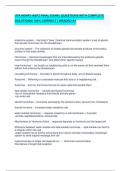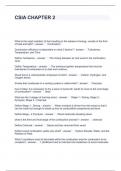UTA HENRY A&P2 FINAL EXAM | QUESTIONS WITH COMPLETE
SOLUTIONS| 100% CORRECT | GRADED A+
endocrine system - the body's "slow" chemical communication system; a set of glands
that secrete hormones into the bloodstream
exocrine system - The collection of ducted glands that secrete products to the body's
surface or into body cavities
Hormones - chemical messengers that are manufactured by the endocrine glands,
travel through the bloodstream, and affect other specific tissues
local hormones - act locally on neighboring cells or on the same cell that secreted them
without first entering the bloodstream
circulating hormones - Circulate in blood throughout body, act on distant targets
Paracrine - Referring to a secreted molecule that acts on a neighboring cell.
Autocrine - term for hormones that act on same cells that secrete them
lipid soluble hormones - -steroid and thyroid hormones
-act on intracellular receptors that directly activate genes
-can enter cell
steroid hormones - hormones secreted by the adrenal cortex; derives from cholesterol
thyroid hormone - increases basic metabolic rate
water soluble hormones - -requires receptors on cell membrane + G-protein
-amines, peptides/proteins, eicosanoids
Mechanisms of Hormone Action - response depends on hormone and the target cell
difference between water-soluble and lipid-soluble hormones - -lipid-soluble can bind to
a receptor within the cell
-water-soluble has to bind to cell surface then wait to activate a secondary messenger
system to send original message w/in cell
responsiveness of target cell depends on... - Hormone's concentration
Abundance of target cell receptors
,Influence exerted by other hormones (permissive, synergistic and antagonistic effects)
Hormones of the Anterior Pituitary - hGH, PRL, ACTH, TSH, tropic, FSH, LH, MSH
hGH (human growth hormone) - stimulates secretion of insulin-like factors that
stimulate body growth, metabolism, and protein synthesis
Thyroid Stimulating Hormone (TSH) - stimulates secretion from thyroid gland
Follicle-stimulating hormone (FSH) - -stimulates production of ova and sperm
-testes stimulate testosterone production
Luthenizing Hormone (LH) - -ovaries stimulate ovulation
-testes stimulate testosterone production
Prolactin (PRL) - stimulates milk production by mammary glands of breasts
Adrenocorticotropic hormone (ACTH) - Stimulates adrenal cortex to secrete
glucocorticoids
melanocyte-stimulating hormone (MSH) - anterior pituitary
tropic hormones - stimulate certain endocrine glands to secrete hormones.
posterior pituitary - -ADH and oxytocin
-does not synthesize hormones
-releases hormones made by hypothalamus
antidiuretic hormone (ADH) - Hormone produced by the neurosecretory cells in the
hypothalamus that stimulates water reabsorption from kidney tubule cells into the blood
and vasoconstriction of arterioles.
Oxytocin (OT) - Increases the contractions of the uterus during birth and promotes the
release of breast milk
Control of thyroid hormone secretion - Thyrotropin-releasing hormone (TRH) from
hypothalamus
Thyroid-stimulating hormone (TSH) from anterior pituitary
Situations that increase ATP demand also increase secretion of thyroid hormones
parathyroid glands - four small glands on the posterior of the thyroid gland
parathyroid hormone - A hormone of the parathyroid gland that regulates the
metabolism of calcium and phosphorus in the body.
,adrenal glands - -a pair of endocrine glands just above the kidneys
-adrenal cortex and adrenal medulla
adrenal cortex - outer section of each adrenal gland; secretes cortisol (glucocorticoid),
aldosterone (mineralocorticoid), and sex hormones (androgens)
adrenal medulla - secretes epinephrine and norepinephrine
anterior pituitary cells - somatotrophs: hGH and IGF
thyrotrophs: TSH
gonadotrophs: FSH and LH
lactotrophs: PRL
corticotrophs: ACTH and MSH
anterior pituitary hypothalamus system - adenohypophysis
posterior pituitary hypothalamus system - neurohypophysis
difference between nervous system and endocrine system - -nervous system sends out
nerve impulses or neurotransmitters that have fast responses, brief effects, and acts on
a specific target
-endocrine system sends out hormones that have slower responses, effects last longer,
and can have a broader influence
Dwarfism - Condition caused by insufficient growth hormone in childhood
Gigantism - hypersecretion of growth hormone from the anterior pituitary before
puberty, leading to abnormal overgrowth of body tissues
Acramegaly - abnormal growth of the hands, feet, and face, caused by overproduction
of growth hormone by the pituitary gland.
Cushing's syndrome - Too much cortisol, CRH, and ACTH
Addison's disease - Too little cortisol, CRH, and ACTH
Hypothyroidism - condition of hyposecretion of the thyroid gland causing low thyroid
levels in the blood that result in sluggishness, slow pulse, and often obesity
Cretinism - condition of congenital hypothyroidism in children that results in a lack of
mental development and dwarfed physical stature; the thyroid gland is either
congenitally absent or imperfectly developed
Hyperthyroidism - overactivity of the thyroid gland
, Graves disease - hyperthyroidism that results in fish eyes
Eurthyroidism - results in goiters (typically around neck)
hyperadrenalism - overactivity of the adrenal glands
Hyperandrogenism - -Excessive production/secretion of androgens
-Pocket Hercules
-Bearded lady
Hypermineralocorticordism - too much aldosterone= sodium and water retention=
hypertension
hypokalemina= too little potassium
calcium homeostasis - Maintenance of a stable level of calcium in the blood
low calcium levels - Parathyroid gland secretes PTH, which stimulates osteoclasts to
break down bone, increasing calcium ions in bloodstream, and stimulating reabsorption
of calcium into kidneys
This will result in calcium levels rising to homeostatic level
high calcium levels - Thyroid gland secretes calcitonin, which stimulates kidneys to
excrete excess calcium ions into bloodstream, where osteoblasts will absorb excess
calcium back into the bones
This will result in calcium levels falling to homeostatic level
thyroid follicles - manufacture, store, and secrete thyroid hormones
Triiodothyronine (T3) and Thyroxine (T4) - -Source: Thyroid (follicular cells)
-Type: Amino acid derivative
-Action: Stimulate metabolic activity
Parofollicular Cells - -C cells
-produce calcitonin (bone in)
-lowers Ca2+ by inhibiting bone resorption
differences between adrenal medulla and adrenal cortex - Adrenal medulla: only
secretes epinephrine and norepinephrine due to ANS message (sympathetic response)
Adrenal cortex: secretes mineralocorticoids, glucocorticoids, and androgens; does not
secrete hormones based off nervous system
pancreatic islets - -both an exocrine and an endocrine gland
-acinar cells and pancreatic islet cells





